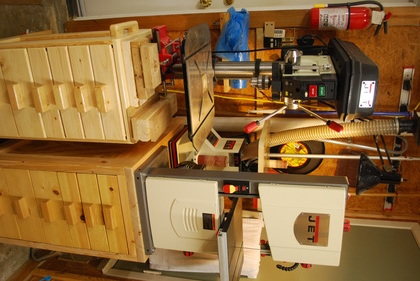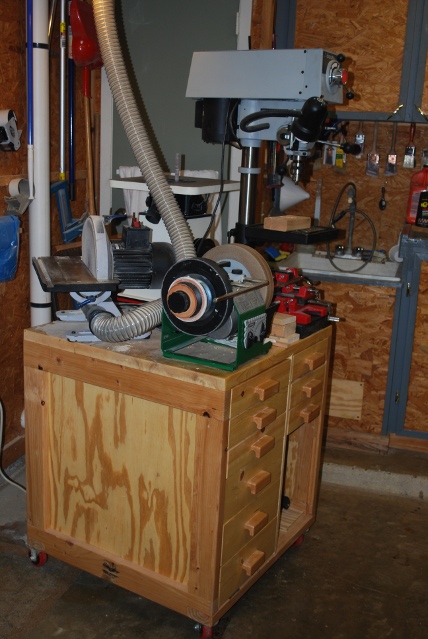
|

|

|

|

|

|

|

|

| |
|
Machine (Tool) Benches
| ||||

|

|

|

|

|

|

|

|

| |
|
Machine (Tool) Benches
| ||||
| Machine Caster Bases | Drawer Samples | Drawer Construction | Loading Bench Construction |
| Lathe Bench | New Miter Saw Bench | Sander Bench | Planer/Mortiser Drawers |
| Table Saw | Dovetail/Sander | Old Multi-Bench |
I had a number of power tools that had to be mounted on something before they could be used. These tools weigh between 50 and 300 LBS. so the mounts must be strong, stable (not move while using the tool), and capable of being pushed or pulled when the tool is moved. I also needed more storage for tools and accessories, some dedicated to specific machines.
Even though cabinet making techniques are used for strength in their construction, they are still work benches. The machine bench design is based on a top of 2X6s laminated together with biscuits, two vertical 2X4 frame sections, and two 2x4 stringers at the bottom holding the vertical frames in position. The benches are built closed on the back and sides with the front open to form a bay for drawers and other storage. To guarantee the bench is rigid and maintained it's dimensional stability (wouldn't parallelogram), I added 1/2" plywood panels on each closed side and the back glued into rabbets. Each bench must be on double locking casters so they could be moved around then locked so it is stable while using the tool. I use #20 biscuits (or plates) to hold the frame and top together this is a form of loose tenon construction. Drawers (I love drawers) are made of a 3/4" flush front, resawed sides and back (dovetailed at the corners), and 1/4" plywood bottom glued into a rabbet, they should easily handle about 50# each. The drawer handles are made of a 4" piece of 2x4 ripped to 1 1/2" and has a 3/4" rabbet cut on the bottom side, it is held on by 2 - 1 5/8" wallboard screws. How I make Drawer Handles. The front bay has drawers starting at the top with an open area below for odd size storage. Other drawers may be added in the storage bay at any time or, as you can see in the pics, other kinds of storage including storage shelves (like the dove tail jig).
Caster Bases:
The caster base raises the tool, but I like the work close to my eyes so I can better see what I'm doing, especially with the bandsaw.
The caster bases are made of 2 by, mitered with loose tennons, then a 3/4" square wood frame glued to the top, just inside the machine's frame to keep the machine in position, gravity holds the machine on it's base.
I make the caster bases about 1" larger (on all sides) than the machine base, to keep it from tipping when being pushed or pulled.
I use double locking casters on these.
Here is a page on caster bases.

|
The dovetail jig is on the woodworking bench, and the sander bench is beside, with drawer out, ready to store the dovetail jig.
|

| Dovetail jig moved to storage drawer (extended) under sander bench. |

| Dovetail drawer in, ready to move the bench back in line. |

| This is the South East corner, there used to be a 32" by 32" bench here I called the multi-bench. But I figured out I needed more flexibility and split it into two benches, the drill press with lift off accesory cabinet and a bench for my 10" bandsaw and spindle sander. You can see the 2" vacuum line and blast gate above, I move the flex line between the 10": bandsaw to the Jet Oscillating Spindle Sander. Note the 'XX' on the fitting above the blast gate, its one I turned from a normal PVC fitting. |

| Closer look at the two benches in the South East corner. The bench on the right was made for the 10" bandsaw and spindle sander using the old multi-bench left side drawers. Here is a rough drawing of the 10" Bandsaw / Sander Bench. This is unique for my benches, its long and narrow. |

| Miter saw bench at the other end of the machine line. Here is a link to the page on the Miter Saw Dust Shroud You'll note I keep an old tennoning jig in this storage bay. |

| Mortiser bench with PowerMatic Mortiser, Tormek sharpener, and , the lathe is normally stored behind this bench. The drawers hold sharpener fixtures and misc other small tools. The storage bay has a 12 drawer cabinet for bullets and brass cases. Here is a link to the construction of that cabinet and it's drawers. Each drawer holds a case of Montanna Gold bullets, a little larger than the post office's "if it fits it ships" boxes. This cabinet has several hundred pounds of bullets in it when this pic was made. |

| Lathe bench, note, no drawer handles, I built a bracket for a 4" vac line which must traverse the entire front on the front tee tracks. There are more pics of the lathe bench in the drawers section. You can see the 2" spacer blocks that raise the lathe above the table top so I would have a place for gouges while I'm turning. |

| The long overhead lumber storage, it was also here originally. I have since added another layer below this for shorter lumber. |

| Looking back at the small bay, with the machine line on the left. If you look close at the overhead storage, you can see the one I added below it. |

|
Old drum sander on it's bench. You can just see the front of the Omni-jig dovetail jig in it's place under the bench drawers. |

|
Drum sander and other machines, circa: 2005. Note the Jet DC-1100 dust collector is still in it's original form, sitting on the shop floor. |

| Old 32" X 32" Multi Bench. Here it has a 7-1/2" Delta drill press, 12" Delta disk sander, Tormec sharpener, and Jet Spindle Sander. I had to get rid of the two Delta tools, drill press and disk sander, along with my Delta 1440 Lathe. It had 9 drawers, six 3-1/2" deep and three 5" deep. This space is now occupied by two benches, drill press and 10" bandsaw. |

|
|